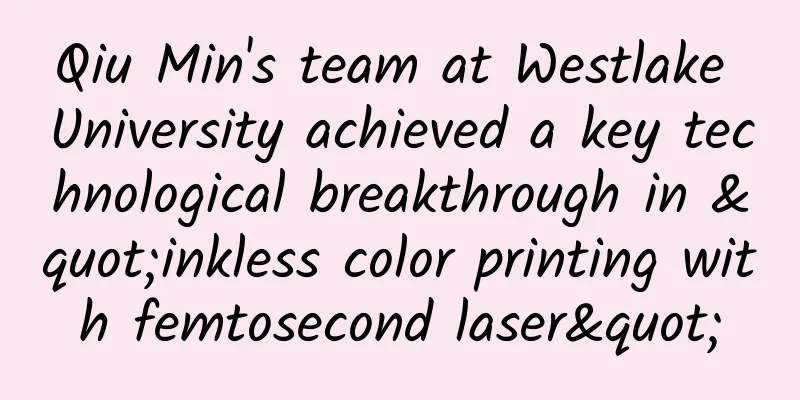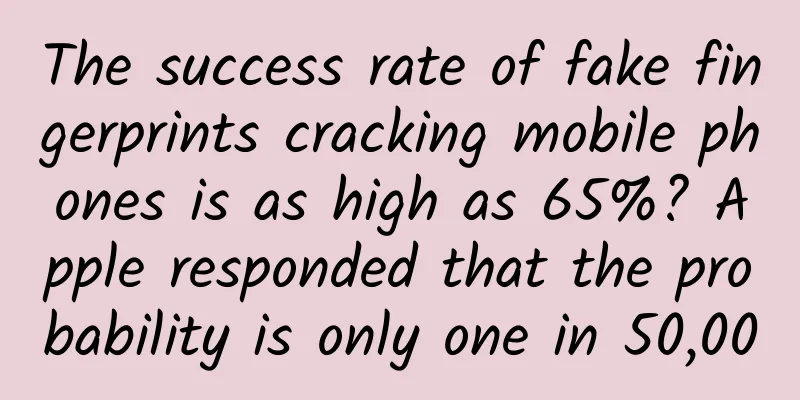Qiu Min's team at Westlake University achieved a key technological breakthrough in "inkless color printing with femtosecond laser"

|
It is 2 inches in diameter and feels as light as a cicada's wing; the pattern contains 13 colors without using a single drop of ink; the colors are rich to the naked eye and will continue to shine for a long time... Last summer, when every first-time undergraduate student of Westlake University opened the gift box of their admission letters, they were pleasantly surprised to notice this unique "science greeting gift" wafer painting inlaid on the admission souvenir card. In fact, the debut six months ago was just the scientists’ first attempt. Recently, we finally got a glimpse of the complete “true face” of this technology. Qiu Min’s team from West Lake University published a related work in the latest issue of Nature Communications titled “High-speed laser writing of structural colors for full-color inkless printing”. They used a composite film composed of two superhard ceramic materials, titanium nitride and aluminum titanium nitride, as special “paper”, and used ultrafast lasers to perform micro-nano processing on its surface to achieve “femtosecond laser inkless color printing”, providing new ideas for the industrial application of laser inkless color printing technology. Familiar "ink-based" printing Any questions? This is a common scene in the office or at home: you lightly press the "Print" button on your computer, and the connected printer efficiently spits out paper. Very conveniently, you hold a color paper version of the electronic content in your hand, whether it is a document, chart or photo. Obviously, this has become a daily routine in many households as color printers have become more commonplace, with nearly 150 million printers currently sold worldwide each year. However, printers are one of the important sources of environmental pollution, because the widely used inkjet or laser color printers require a large amount of ink or toner, which will cause significant pollution to the environment and harm the human body. The ink contains a certain concentration of volatile harmful substances and elements such as lead, cadmium, mercury, and polybrominated biphenyls; when the printer is working, the toner will also release a large number of microparticles that can be absorbed by the human body. Studies have shown that in a closed room, when the printer is working, the number of suspended particles in the air will be five times higher than usual. How to get rid of "ink"? Humans are once again "learning" from nature. Do you remember the time when you admired the colorful wings of butterflies or insects up close, or observed the colorful feathers of birds? You thought their dazzling colors came from the pigments (chemical colors) in their bodies, but in fact, this is a masterpiece of structural colors (physical colors). When light shines on a large number of ordered structures in subtle places, reactions such as refraction, diffuse reflection, diffraction or interference will occur, thus generating colors. In fact, no "pigments" are used in this process. And compared with pigments, structural colors have the advantages of not fading, high resolution, and environmental protection. So, can we follow the example of nature and apply structural colors to inkless printing? Scientists have made a bold attempt to use ultrafast lasers to create micro-nano structures on the surface of materials to produce structural colors, namely ultrafast laser color printing technology. In this technology, light (laser) is the "pen" and the "caster" of the special structural "canvas". For example, the various traditional anti-counterfeiting code papers around you use the rainbow colors produced by laser-induced self-organized nano-gratings. It has certain application value in anti-counterfeiting, but it cannot produce patterns of specified colors. In Canada, this technology is also used to print coins and commemorative coins, but its printing color gamut is narrow, covering only 15% of the color gamut of the standard RGB standard color system; and it can only be produced on the surface of precious metals, which means that there are great restrictions on materials; the color wear resistance is also poor and it is easy to fade. That is to say, despite various explorations and attempts by scientists, there are more or less "shortcomings". How to broaden the color gamut of ultrafast laser color printing (that is, to be able to print more colors) and achieve color that does not change with the viewing angle has become a key issue that needs to be broken through in the current research on laser coloring technology. Using ceramics as "paper" and laser as "pen" What kind of sparks will be created? Nanophotonics and Instrument Technology Laboratory, this is the "big name" of Qiu Min's laboratory at Westlake University. Qiu Min, the head of the laboratory, has been "walking towards light" for more than 20 years, focusing on the research in the field of micro-nano photonics. Over the past year, researchers in Qiu Min's laboratory have innovatively proposed using ultrafast lasers to process ceramic composite ceramic films, achieving a key breakthrough in ultrafast laser color printing technology. Figure 1. Schematic diagram of the principle of ultrafast laser coloring on the surface of composite ceramic films The core of this technology lies in the fact that they invented a novel "paper" - the thickness is only about 110 nanometers, only one thousandth of a hair. This "paper" is divided into three layers: as shown in Figure 1, the researchers successively plated 50 nanometers of titanium nitride and 60 nanometers of aluminum titanium nitride on a single crystal silicon substrate. The first layer, which is the bottom layer from top to bottom, is metallic titanium nitride, which will serve as a light reflection layer - its function is to block light penetration and increase brightness. The second layer is a high-loss aluminum titanium nitride dielectric, which will regulate the absorption of natural light - as we know, the color of an object is determined by the light they absorb. The third layer is the top layer of aluminum oxide - when the ultrafast laser acts on the surface of aluminum titanium nitride, an additional transparent film mainly composed of aluminum oxide will be formed, which will work with aluminum titanium nitride to regulate the absorbed natural light. Due to their high hardness, titanium nitride and aluminum titanium nitride are called ceramic materials. This layer of "ceramic" made of feather-light "paper" will become the "outer coat" attached to the object on which the pattern needs to be printed. At the same time, Qiu Min's team developed another use for the "pen" - this pen is still a laser, but in their technology, this pen no longer creates structures directly on the surface of the object, but will "carve" on the ceramic film paper. The laser will be projected on the film, and by controlling the energy or scanning speed of the incident laser, the thickness of the oxide film (aluminum oxide) and the aluminum titanium nitride film can be changed at the same time; after the thickness changes, the incident natural light will form a specific reflection color through the complex interference effect between the three-layer film structure. Thus, the rich and colorful colors are formed, as shown in Figure 2a. Figure 2. Typical color palette (a) and color gamut range (b) of laser printing Subsequently, the researchers used a variety of technical means such as energy dispersive X-ray, X-ray photoelectron spectroscopy, X-ray diffraction, and focused ion beam etching to analyze the laser-colored area, confirming that the observed color did come from the laser-induced oxide layer. In other words, the "paper" and "pen" they developed finally achieved the ideal laser color inkless printing. Colorful, efficient, timeless Restore the beautiful world Every step forward in scientific research requires down-to-earth verification. After a brief celebration, the research team immediately began to test the new technology. They were pleasantly surprised to find that the "special paper" made of two super-hard ceramic materials, titanium nitride and aluminum titanium nitride, can achieve high-speed, high-resolution, wide color gamut, large size, observation angle-insensitive, and aging-resistant full-color ink-free laser printing. Wide color gamut. At present, the "femtosecond laser inkless color printing" technology invented by Qiu Min's laboratory has achieved nearly 90% of the RGB standard color system (as shown in Figure 2b), far exceeding the current mainstream laser coloring technology. The researchers explained that compared with the previous "laser-induced oxide film formation on the surface of stainless steel" traditional laser coloring scheme, the former forms a single-layer oxide film with only one variable variable, while their laser-induced composite film oxidation will be able to change the thickness of the oxide film (aluminum oxide) and the aluminum titanium nitride film at the same time, with one more degree of freedom, thus obtaining a wider color gamut. High speed and high resolution. This technology can achieve both high-speed and high-resolution full-color ink-free printing. In terms of printing speed, this technology has reached a record 10cm2/s, as shown in Figure 3. This means that a piece of A4 paper can be printed in full color within 1 minute. In terms of printing resolution, the researchers demonstrated 10,000 dpi color printing, which is more than 10 times the highest resolution of traditional ink printing. The color does not change with the observation angle. The high absorption characteristics of aluminum titanium nitride make it produce a considerable additional phase difference at its interface, which offsets the color change caused by the difference in film thickness with the observation angle; in simple terms, it is precisely because this "feather" is so thin that within the range of 0-80°, no matter at which angle it is observed, the color basically does not change, which is another difficult problem in the field of laser coloring (as shown in Figure 4). The colors are "timeless". The researchers conducted a series of destructive experiments, tested the aging in a high temperature and high humidity environment (double 85 test), tested the corrosion resistance in a salt spray environment, and conducted experiments such as photobleaching and adhesion, but the "femtosecond laser inkless color printing" works are still "timeless". This is because the dense aluminum oxide film formed on the surface of aluminum titanium nitride acts as a good protective layer. After a series of national standard anti-aging tests, the researchers further confirmed that the color difference induced by laser on aluminum titanium nitride is still less than 7, which fully meets the needs of industrial applications. Figure 4. Laser-colored color plates viewed from different angles The last step of the experiment is the most "colorful" and "gorgeous". Can you believe that this is a "masterpiece of art" from a group of engineering students? Picasso's famous painting "Weeping Woman" "Spring Morning in the Han Palace" by Qiu Ying, a famous Ming Dynasty painter—— Wang Xizhi's calligraphy "Lanting Preface" Among them, "Spring Morning in the Han Palace" was printed on a rough, unpolished single-crystal silicon surface, and "Preface to the Lanting Collection" was printed on a soft steel foil. This will also be a huge advantage of this laser printing technology over traditional micro-nano processing technologies (such as electron beam etching and nanoimprinting) that also present structural colors. In 2022, the first batch of undergraduate students of Westlake University, more than 20 members of the Westlake University Advisory Committee, including Yang Zhenning, became the first witnesses of this technology (Figures 5-6). Figure 5. Admission souvenirs made by researchers from Qiu Min’s laboratory for the first batch of undergraduates at Westlake University Figure 6. A souvenir made by researchers from Qiu Min’s laboratory for Mr. Yang Zhenning In the future, how will this technology change our lives? The research team members joked that this open-ended question is left to the public to answer. "You can imagine, we are responsible for realizing it" - after the release of "The Wandering Earth 2", China Aerospace Science and Technology Corporation, China National Petroleum Corporation, China Petrochemical Corporation, COFCO Corporation and others all responded to the magnificent fantasy of the film. And this call is exactly the voice of Qiu Min's team. The mission of scientists is to explore the realm that has not been reached by predecessors and turn the impossible into possible step by step. News reading aid Let this "light and shadow masterpiece" go further The road from 0 to 1 is always full of thorns. On the technical level, Dr. Geng Jiao, the first author of this article, said that the most difficult part is parameter debugging. In order to present nearly 90% of the RGB standard colors, they modified it hundreds of times before the encounter between the laser and the film could create sparks of the correct color. There is no precedent for such modification. The most challenging thing is to generate the "inspiration" of the technology itself. In fact, the main structure of the "paper" developed by the institute, that is, adding a semiconductor absorption layer on the metal reflective layer, is the common structure of traditional micro-nano processing to produce structural colors; but combining this structure with laser means and replacing more suitable materials to "print" colorful colors is an attempt that "has never been done before." The development of this technology took only about a year. Such efficient innovation is based on the shoulders of "predecessors" and the team's accumulated research over the years. Qiu Min's team has been conducting research on regulating light absorption through micro-nano structures for more than a decade. Dr. Shi Liping, one of the corresponding authors, learned about titanium nitride during his long-term cooperation with Professor Harald Giessen of the University of Stuttgart while doing a postdoctoral fellowship in Germany. In terms of ultrafast laser color printing technology, a detailed review of this field by Academician Hong Minghui, formerly of the National University of Singapore and now of Xiamen University, made the team pay attention to the existing technical means and bottlenecks of laser inkless coloring. Just last year, the team proposed the use of three superhard ceramic materials, titanium nitride (TiN), aluminum nitride (AlN) and titanium aluminum nitride (TiAlN), to achieve ultra-thin color optical coatings that are super wear-resistant (published in PhotoniX); it was in this study that the team noticed the optical and mechanical properties of titanium nitride and titanium aluminum nitride, which gave rise to the idea of migrating these two materials to inkless printing technology... Of course, the current results do not mean the end. It contains new challenges and is also a new starting point. In the future, Qiu Min's team will continue to develop this technology and achieve new breakthroughs: for example, by optimizing the parameters of lasers and composite films, further broadening the color gamut of laser printing technology and improving saturation and color brightness; expanding new materials so that colors can be printed and erased, reducing printing costs; combining with artificial intelligence technology, allowing computers to replace human eyes to select corresponding color blocks and print directly... They will keep chasing "light". Westlake University is the only institution that completed the paper. Dr. Geng Jiao is the first author, Dr. Shi Liping and Guoqiang Chair Professor Qiu Min are the corresponding authors, and co-authors include doctoral students Xu Liye and Dr. Yan Wei. The research was funded by the National Natural Science Foundation of China and the Natural Science Foundation of Zhejiang Province, and technical support from the micro-nano processing platform and physical and chemical testing platform of Westlake University. Original link: https://www.nature.com/articles/s41467-023-36275-9 |
<<: After school starts, two diseases are prevalent, parents must pay attention →
>>: Test who you are among the Three Body?
Recommend
Tesla: Tesla's sales in China reached 137,200 units in Q1 2025, a three-year high
Tesla recently announced its first quarter delive...
How Rice and Arabidopsis Change After 120 Days of Space Travel
On December 4, rice and Arabidopsis seeds that ha...
Do these 5 things well and the click-through rate of information flow advertising materials will increase by 90%
What does craftsmanship require? Humility, persev...
BYD's second-generation Yuan PLUS Intelligent Driving Edition: a new benchmark for A-class pure electric SUVs in the era of intelligent driving equality
On March 5, 2025, BYD Dynasty series added anothe...
Unveiling the 12306 team: Fighting against ticket machines for a year
[[219796]] On February 2, at the China Academy of...
Cocos by Touch Technology won the title of National Cultural Industry Game Engine
Recently, Chukong Technology's cocos professi...
What are the pitfalls of APP promotion and how is channel promotion done?
There is a saying that "channels are king&qu...
These 4 pages of PPT will help you understand what Internet "content marketing" is
In recent years, content marketing has become a h...
Cloud Native for Big Companies 2021
Course Catalog 01. What is cloud computing? 02. C...
Will Super App + Web App dominate the future of mobile Internet?
[[125521]] Since W3C released HTML4 in 1999, the ...
Ask yourself! 15 questions that IT technicians must think about
People in the industry call themselves programmer...
Living room big screen returns to the center of home entertainment, data will become the biggest gold mine for OTT marketing
It has become a global trend for users to return ...
China Association of Automobile Manufacturers: A brief analysis of the production and sales of new energy vehicles in January 2022
According to statistics and analysis by the China...
Lenovo Z5: A truly conscientious and high-quality smartphone that stands out among the thousand-yuan smartphones
Lenovo first launched the "conscientious qua...
How to promote a new App?
Since I often write about App promotion, friends o...









